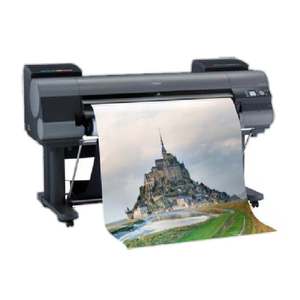
Do you ever find it difficult to work out what kinds of print media are suitable for use in your large format inkjet printer? Or unsure what kind of large format printer to purchase.
Here is a “simple language” glossary of a few jargon terms that might help!
- AQUEOUS – This means “containing water” or “water-based” and is the term used in large format printing to describe dye and pigment ink types. Any large format media described as “Aqueous” eg Whitegold Aqueous Inkjet Media will work on printers that use dye or pigment inks. Examples of these printers are HP Designjet Z-series e.g. Z5200/Z6200 etc, HP Designjet 1000/5000/5500 etc, Canon ipf series eg ipf 760/800/815/8000/8400 etc, Epson Stylus 7600/9600/7800/9800/9700/9880 etc and new T3200/5200/7200. If you are unsure, it is most likely that your printer uses aqueous inks and media. Aqueous media is generally coated with a special coating to allow the ink to sink in and dry well; there is a large range of substrates to choose from.
- DYE INK – This water-based aqueous ink type uses older technology and is rare in new printers. Older printers such as HP Designjet 5000 etc may use dye ink. Dye ink fades quite quickly and is not water resistant, hence why pigment ink has largely taken over. All Whitegold Aqueous Inkjet Media will work on printers that use dye ink for indoor prints only; even short-term outdoor use is not recommended. Dye printers are generally used for general CAD and poster work.
- PIGMENTED INK – Pigmented ink is a much more advanced water-based ink, and is used in nearly all new aqueous inkjet printers eg HP Designjet Vivera ink for Z-series etc, “UV” ink on HP Designjet 5000/5500, Epson Ultrachrome ink, Canon Imageprograf (ipf) etc. Pigment inks are colourfast and remarkably water-resistant (not waterproof – they are still ultimately water-based) so can be used for long-term indoor and short-term outdoor. Pigment inks are best for fine art and photo quality prints. All Whitegold Aqueous Inkjet Media will work with Pigment Ink Printers; there is a remarkably large range of substrates available!
- SOLVENT INK – As the name suggests, solvent ink is solvent-based or “oil-based” and is not soluble in water. Therefore solvent ink is waterproof and very durable, although it does emit a powerful odour so needs to be used in a controlled environment. Solvent inkjet printers will only work with solvent inkjet media, which can be either coated or uncoated. Solvent printers can print brilliant colours on a large range of substrates including vinyls, films, papers, textiles etc, and printed output is suitable for long-term outdoor use when printed on durable material – see Whitegold Solvent Inkjet Media for more information. Examples of solvent printers include Seiko Colorpainter,
- ECO-SOLVENT INK – Eco-solvent ink has similar properties to solvent ink but is less harmful to the environment with reduced odour. Most modern solvent-based inkjet printers on the market today use eco-solvent or mild solvent inks, e.g. Roland Versacamm, Roland Soljet, Mimaki JV33, Mutoh, Epson Surecolour etc. Eco-solvent printers use all the same materials as solvent printers - see Whitegold Solvent Inkjet Media for more information.
- LATEX INK – this is a revolutionary new type of ink developed by Hewlett Packard; it is water-based pigmented ink made using latex polymer technology, greatly improving the water-resistance and durability of the ink and enabling it to be used for medium-long term outdoor use. Latex ink has distinct environmental advantages over solvent/eco-solvent because it is virtually odourless, non-flammable and non-combustible, meaning that no warning labels are required. Latex printers require no special ventilation and can be used in an office environment. Examples of HP Latex Printers are Designjet L25500/26500, Latex 300 series e.g. Latex 360 etc. See Whitegold Latex Inkjet Media for more information.
- UV-CURABLE INK – UV ink is a very tough, non-hazardous formulation which can be used to print directly onto a large variety of both flexible and rigid materials including wood, foam board, glass, aluminium composite etc. This enables the printer to eliminate the process of mounting and laminating; a major time and cost saving. UV inks sit on the surface of the substrate and are cured by intense UV/LED light, leaving a durable film on the surface. UV inks are economical to run and enable quick production, but the initial investment cost for printers is significantly higher. Most Whitegold Solvent Inkjet Media are suitable for UV curable inks.
- COATED MEDIA – When talking about inkjet media, the term “coated” is used to describe any printable substrate that has had a layer coated on the top to receive the ink or improve the result. Nearly all aqueous media (with the exception of cheap CAD 80gsm/90gsm paper) is coated with either a matt, satin or gloss coating; nowadays these coatings are generally microporous for use with pigment or dye ink types. While solvent/eco-solvent printers can print onto uncoated vinyls etc, a large number of solvent medias are also coated for improved results.
- MICROPOROUS COATING – This is a special coating applied to substrates for printing using aqueous pigmented inks (dye inks will work too). Microporous coating allows the ink to penetrate improving drying times and water-resistance. All Whitegold Aqueous Inkjet Media have microporous coatings.
- SWELLABLE COATING – This is a special coating applied to substrates for printing using aqueous dye inks only. A swellable coating enables the ink to dry on the surface of the media. Pigmented inks will not dry at all on this type of media! No Whitegold Aqueous Inkjet Media have swellable coatings, as there are less and less dye-based printers still around.
